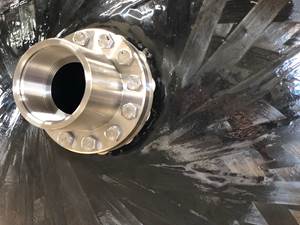US wind power booming
The roster of U.S. wind projects under construction and in advanced development as of the end of the third quarter of 2017 has reached 29,634 megawatts (MW), the highest level since this statistic was first measured at the beginning of 2016, according to a new report from the American Wind Energy Association.
The roster of U.S. wind projects under construction and in advanced development as of the end of the third quarter of 2017 has reached 29,634 megawatts (MW), the highest level since this statistic was first measured at the beginning of 2016, according to a new report from the American Wind Energy Assn. (AWEA, Washington, DC, US) released on October 26. The “U.S. Wind Industry Third Quarter 2017 Market Report” shows wind power is competing for and winning the business of a growing set of major utilities and Fortune 500 brands.
AWEA released the report at the annual Wind Energy Finance & Investment Conference in New York. Interest was evident from the U.S. wind power capital market, with a large number of investors, including tax equity, private equity, institutional, sovereign wealth funds, and banks, looking to provide financing to wind projects.
“Wind power’s value to investors, utilities and corporate purchasers is clear: fixed-cost
clean energy at competitive prices,” says Tom Kiernan, CEO of AWEA. “The high level of
wind under construction and in advanced development shows we are on track to deliver
10 percent of America’s electricity by 2020, along with $85 billion in economic activity
and 50,000 new jobs.”
With year-over-year construction and advanced development activity up 27 percent,
wind’s strong growth reflects a new status quo – with wind power competing for, and
winning, a place in the energy mix of some of America’s largest companies. The
combined pipeline of 29,634 MW of wind capacity includes 13,759 MW under
construction and 15,875 MW in advanced development, defined as not yet under
construction, but having signed a power purchase agreement, proceeding under utility
ownership, or announcing a firm turbine order. Within the pipeline, new third quarter
activity represents 4,248 MW of capacity entering advanced development and 638 MW
beginning construction.
Utilities made large-scale announcements to develop and own wind power during the
third quarter, including American Electric Power’s (AEP) 2,000 MW Wind Catcher
project in Oklahoma, Alliant Energy’s 500 MW New Wind II project in Iowa, and Xcel
Energy’s 300 MW Dakota Range I and II in South Dakota. The companies’ executives
have spoken to the affordability and reliability of wind.
“There’s a rebalancing of the generation resources, not only in our company but in this
country, that’s going on,” says Nick Akins, the chief executive of AEP. “This project is
consistent with our strategy of investing in the energy resources of the future, and it will
save our customers money while providing economic benefits to communities.” Doug Kopp, president of Alliant Energy’s Iowa utility, says, “The goal of this project is to
bring additional low-cost, clean energy to ourcustomers and the State of Iowa.” Chris Clark, president of Xcel Energy – Minnesota, South Dakota, North Dakota said,
“Our customers count on us to provide reliable, affordable and clean energy, and this
investment will do just that."
Fortune 500 companies contracting for wind power have emerged as another major
demand driver. The low, stable price of wind makes business sense, helping them to
cost-effectively meet sustainability goals. The third quarter witnessed a broadening and deepening of this customer base. Four corporations signed power purchase agreements for the first time, including major manufacturers Anheuser-Busch, Cummins, and Kimberly-Clark. Target and General Motors also became repeat customers, having previously signed PPAs.
View a map of every wind farm and factory in America: http://gis.awea.org/arcgisportal/apps/webappviewer/index.html?id=eed1ec3b624742f8b18280e6aa73e8ec.
Related Content
Infinite Composites: Type V tanks for space, hydrogen, automotive and more
After a decade of proving its linerless, weight-saving composite tanks with NASA and more than 30 aerospace companies, this CryoSphere pioneer is scaling for growth in commercial space and sustainable transportation on Earth.
Read MoreWe4Ce infused 2.5-3-MW rotor blade design passes validation test
Composite rotor blade structure design by We4Ce, mold and prototype production by InDutch Composites and fatigue testing by Suzlon Group has resulted in the novel blade’s IEC61400-5:2020 certification.
Read MoreCeramic matrix composites: Faster, cheaper, higher temperature
New players proliferate, increasing CMC materials and manufacturing capacity, novel processes and automation to meet demand for higher part volumes and performance.
Read MoreSRI develops scalable, infiltration-free ceramic matrix composites
Work in two DOE projects is demonstrating C/C-SiC produced in 3-5 days with <5% shrinkage, <10% porosity and 50% the cost of conventional C/C and C/C-SiC.
Read MoreRead Next
Next-gen fan blades: Hybrid twin RTM, printed sensors, laser shock disassembly
MORPHO project demonstrates blade with 20% faster RTM cure cycle, uses AI-based monitoring for improved maintenance/life cycle management and proves laser shock disassembly for recycling.
Read MoreCutting 100 pounds, certification time for the X-59 nose cone
Swift Engineering used HyperX software to remove 100 pounds from 38-foot graphite/epoxy cored nose cone for X-59 supersonic aircraft.
Read MoreScaling up, optimizing the flax fiber composite camper
Greenlander’s Sherpa RV cab, which is largely constructed from flax fiber/bio-epoxy sandwich panels, nears commercial production readiness and next-generation scale-up.
Read More












